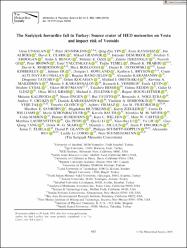The Saricicek howardite fall in Turkey: Source crater of HED meteorites on Vesta and impact risk of Vestoids

Göster/
Erişim
info:eu-repo/semantics/openAccessTarih
2019Yazar
Ünsalan, OzanJenniskens, Peter
Yin, Qingzhu
Kaygısız, Ersin
Albers, Jim
Clark, David L.
Schmedemann, Nico
Üst veri
Tüm öğe kaydını gösterÖzet
The Saricicek howardite meteorite shower consisting of 343 documented stones occurred on September 2, 2015 in Turkey and is the first documented howardite fall. Cosmogenic isotopes show that Saricicek experienced a complex cosmic-ray exposure history, exposed during 12-14Ma in a regolith near the surface of a parent asteroid, and that an 1m sized meteoroid was launched by an impact 22 +/- 2Ma ago to Earth (as did one-third of all HED meteorites). SIMS dating of zircon and baddeleyite yielded 4550.4 +/- 2.5Ma and 4553 +/- 8.8Ma crystallization ages for the basaltic magma clasts. The apatite U-Pb age of 4525 +/- 17Ma, K-Ar age of 3.9Ga, and the U,Th-He ages of 1.8 +/- 0.7 and 2.6 +/- 0.3Ga are interpreted to represent thermal metamorphic and impact-related resetting ages, respectively. Petrographic; geochemical; and O-, Cr-, and Ti-isotopic studies confirm that Saricicek belongs to the normal clan of HED meteorites. Petrographic observations and analysis of organic material indicate a small portion of carbonaceous chondrite material in the Saricicek regolith and organic contamination of the meteorite after a few days on soil. Video observations of the fall show an atmospheric entry at 17.3 +/- 0.8kms(-1) from NW; fragmentations at 37, 33, 31, and 27km altitude; and provide a pre-atmospheric orbit that is the first dynamical link between the normal HED meteorite clan and the inner Main Belt. Spectral data indicate the similarity of Saricicek with the Vesta asteroid family (V-class) spectra, a group of asteroids stretching to delivery resonances, which includes (4) Vesta. Dynamical modeling of meteoroid delivery to Earth shows that the complete disruption of a 1km sized Vesta family asteroid or a 10km sized impact crater on Vesta is required to provide sufficient meteoroids 4m in size to account for the influx of meteorites from this HED clan. The 16.7km diameter Antionia impact crater on Vesta was formed on terrain of the same age as given by the He-4 retention age of Saricicek. Lunar scaling for crater production to crater counts of its ejecta blanket show it was formed 22Ma ago.


















